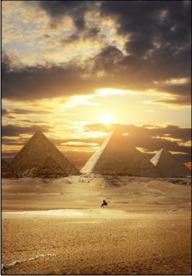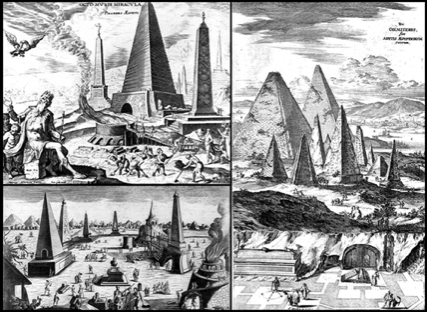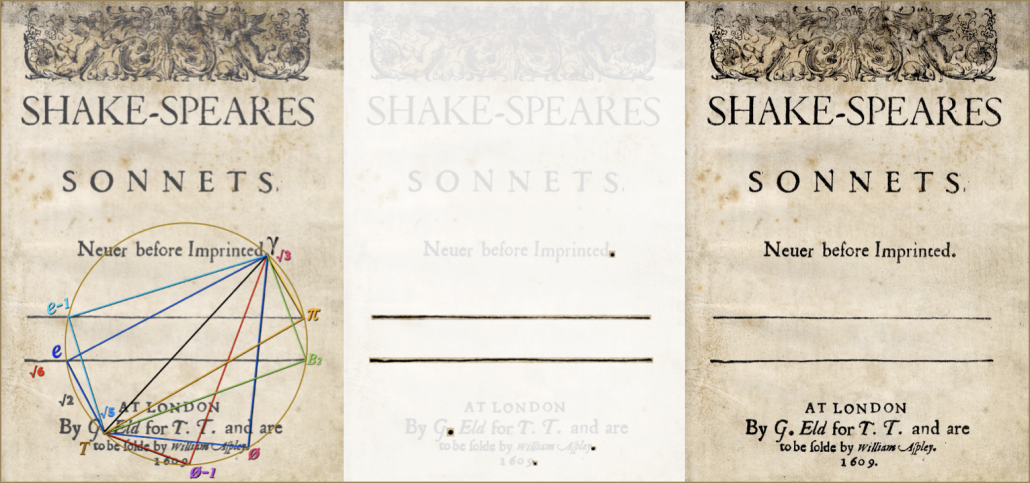
THE GREAT PYRAMID
Why is Shakespeare insisting we look at Giza?
The Great Pyramid of Giza is the oldest man-made structure on earth, the last survivor of the Seven Wonders Of The Ancient World. The massive monument comprises 2.3 millions stones weighing 6.5 million tons sitting on a square base the size of six football fields. The average weight of each limestone block is over 2.5 tons and they’re laid in such near-perfect alignment with true north that we couldn’t match their precision today. Larger granite blocks that make up the inner King’s Chamber, weigh between 50 and 80 tons each and are cut so perfectly you can’t slide a razor blade between them.
Named after the Fourth Dynasty pharaoh, Khufu (circa 2600~2500 BCE), Egyptologists insist it was constructed solely to be his tomb. But no mummified remains have ever been found inside any Egyptian pyramid so non-traditional scholars conclude they had an altogether different purpose. Given the phenomenal accuracy with which the Great Pyramid was built many are convinced it dates from a remote golden age when higher mathematics and art, they believe, were combined to convey divine principles.

Based on Khufu’s known lifespan the official party line is the structure had to have been completed in twenty years otherwise the tomb story doesn’t work. But even with a maximum possible 16-hour shift every single day for 20 years (assuming there were no flood-lights for night work) it would require quarrying, transporting, dressing and precision-placing one Cadillac-sized stone every three minutes! But that’s impossible! So something has to be adjusted to make the math fit, hence the story we all learned in school: it was done with the forced labor of 100,000 slaves. We’re not told how they organized such a logistical nightmare, of course. The porta-potty situation, for instance?
But leave that as unsolvable for now. What’s of interest here is why Shakespeare (with John Dee, on his behalf) performed the almost inconceivable task of encoding the geographic coordinates of the Giza complex into the punctuation on the Sonnets title page. If you haven’t already seen the full BARDCODE Sonnets Preview video under the Mystery menu, check it out. But here’s a short-cut to the Grand Finale:
So how impossible is what you just saw? Notice the latitude is practically spot on… mere feet north of the exact centre line of the pyramid. It’s 99.999% accurate, in fact! The longitude is off by about 350 yards from centre (99.99%). But we need to understand that in 1609 the science of how to calculate longitude was not even known. Galileo was still wrestling with the problem when he died 25 years after Shakespeare’s passing.
In 1599 the Wright-Molyneux Map was hailed both for its extraordinary accuracy and honesty. Where previous cartographers had put in all kinds of wild, squiggly speculation whenever coastline details were still unknown, Wright had truthfully depicted hundreds of miles with straight lines indicating, in effect… we just don’t know yet. (Shakespeare shows he’s aware of this by having Maria joke about Malvolio, in Twelfth Night : “He does smile his face into more lynes, then is in the new Mappe, with the augmentation of the Indies.” In other words he smiles but doesn’t know a thing!)
Nevertheless, despite the Wright-Molyneux’s extraordinary accuracy, the longitude settings between Greenwich and Giza were still off by 1º, which translates to about 70 miles on the ground. The idea that in 1609 anyone could calculate longitude accurate to within 350 yards of the pyramid’s centre is frankly astonishing.

What makes this all the more astounding is that when Shakespeare’s Sonnets was published in 1609 the world was in complete ignorance about pyramids in general. These engravings (from before, during, and long after the poet’s life) show various artists’ impressions of what they believed the pyramids looked like.

The first book on the subject, Pyramidographia, by John Greaves, wasn’t published until 1646… thirty years after Shakespeare’s ‘official’ death. And it wasn’t until 1836 that Colonel Howard Vyse published the first accurate measurements of the pyramid. They attracted the attention of the publisher of London Magazine, John Taylor, who in 1859 published The Great Pyramid; Why Was it Built: and Who Built it?, in which he speculated about close correlations between the pyramid’s proportions and the math constants Pi and Phi.
Yet all that (and far more!) had already been brilliantly encoded in 1609 using just four dots and two lines.

Unknown longitude? Unknown constants? Unknown pyramid dimensions? And then there’s the fact that Greenwich would not be established as the Prime Meridian until 1884! What on earth are we dealing with here?
